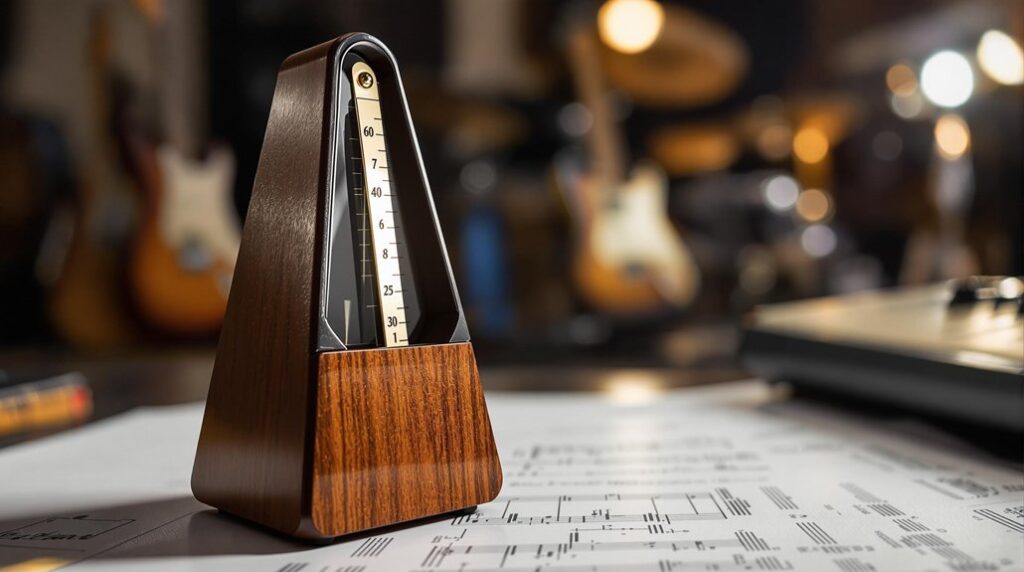The primary distinction between major and minor scales lies in their intervallic patterns and the resultant emotional effects. Major scales follow the pattern of whole-whole-half-whole-whole-whole-half steps, producing a bright, uplifting sound. In contrast, minor scales follow a whole-half-whole-whole-half-whole-whole pattern, creating a sound that is often darker and more introspective. The difference in intervals, particularly the major third in major scales versus the minor third in minor scales, greatly affects their emotional impact. Furthermore, understanding relative scales and their roles in chord progressions can greatly enhance a musician’s compositional and improvisational skills. Explore further for an extensive understanding.
Key Takeaways
- Major scales follow the pattern W-W-H-W-W-W-H, while minor scales follow W-H-W-W-H-W-W.
- Major scales typically evoke happiness and brightness; minor scales often convey sadness and introspection.
- The third interval of major scales is a major third, whereas minor scales have a minor third.
- Relative minors share the same notes as their major counterparts but start on the sixth degree of the major scale.
- Understanding the emotional impact of major and minor scales helps shape the mood and progression in music composition.
Scale Construction
Scale Construction
Scale construction is fundamental to understanding the emotional and structural differences between major and minor scales. Major scales are built using a specific pattern of whole (W) and half (H) steps: W-W-H-W-W-W-H. This sequence produces a sound that is characteristically bright and cheerful. For example, the C major scale follows this pattern: C, D, E, F, G, A, B, C.
In contrast, minor scales adhere to a different pattern: W-H-W-W-H-W-W, resulting in a darker and more somber tone. Taking the A minor scale as an example, the notes are A, B, C, D, E, F, G, A.
A significant structural difference lies in the third note: the major scale’s third note forms a major third interval above the tonic, while the minor scale’s third note is a minor third, one half step lower. Additionally, practicing rhythmic patterns and using a metronome aids in developing a steady sense of timing, which is vital for timing in both major and minor scales.
Additionally, the relationship between major and minor scales can be understood through relative minors. To find the relative minor of a major scale, one starts on the sixth degree of the major scale and counts down three half steps.
This understanding of scale patterns and specific scale examples is essential for recognizing their distinct structural characteristics, which are foundational in musical composition.
Emotional Impact
The emotional impact of major and minor scales is profound and unmistakable in musical composition. Major scales, with their bright and cheerful sound, are typically associated with feelings of happiness and positivity. This emotional resonance is largely due to the major third interval above the tonic, which creates an uplifting and vibrant quality in the music.
In contrast, minor scales evoke a darker and more somber emotional quality, often conveying feelings of sadness or introspection. The minor third interval above the tonic in minor scales fundamentally alters the emotional impact, infusing the music with a sense of melancholy and depth.
The choice of scale can also affect the chord progressions used, further influencing the piece’s mood and emotional direction. Understanding these emotional implications is essential for musicians aiming to enhance their expressive capabilities, allowing them to convey specific feelings more effectively in their compositions.
The strategic use of major and minor scales enables mood alteration within a musical work, guiding the listener’s emotional journey and enriching the overall narrative. Consequently, the selection of scale is not merely a technical choice but a powerful tool for emotional expression in music.
Relative Scales
Relative scales represent a fundamental concept in music theory, providing a bridge between major and minor tonalities and enriching the harmonic palette of musicians. The relative minor scale shares the same notes as its corresponding major scale but starts on the 6th degree. For instance, A Minor is the relative minor of C Major. This relationship is essential for understanding relative scale relationships, enhancing a musician’s ability to navigate various key signatures and tonal centers.
Additionally, modes like Dorian and Phrygian can further expand the creative possibilities within these scales.
To identify the relative minor of a major scale, one can count down three half steps from the tonic note or count up a sixth. For example, counting down from C to A or up from C to A identifies A Minor as the relative minor of C Major. This method of relative minor identification simplifies the process of modulating between keys and exploring different emotional landscapes.
Despite sharing identical pitches, the major scale typically sounds bright and uplifting, while its relative minor conveys a darker, more introspective mood. Recognizing these relationships aids musicians in effective songwriting and improvisation, allowing them to seamlessly shift between contrasting tonalities and deepen their expressive range.
Understanding relative scales is therefore indispensable for thorough musical comprehension.
Chord Progressions
Understanding chord progressions is essential for musicians seeking to create compelling and emotionally resonant compositions. Chord progressions in major keys commonly follow the I-IV-V pattern, producing a bright and uplifting sound. Conversely, minor keys often employ the i-iv-V progression, leading to a darker and more somber atmosphere. The emotional impact of these progressions is evident in popular music; for instance, major chords in “Celebration” by Kool and the Gang evoke joy, whereas minor chords in “Where Is My Mind” by Pixies elicit introspection.
Mastering chord variations within these progressions allows musicians to shift seamlessly between major and minor chords, exploring diverse emotional landscapes. Common progression examples such as the ii-V-I in major keys or ii-V-i in minor keys are foundational in jazz, showcasing their versatility and emotional depth.
| Chord Progressions | Major Key Example | Minor Key Example |
|---|---|---|
| Primary Pattern | I-IV-V | i-iv-V |
| Emotional Impact | Uplifting, Bright | Somber, Dark |
| Popular Song | “Celebration” | “Where Is My Mind” |
| Jazz Foundation | ii-V-I | ii-V-i |
Proficiency in major and minor chord progressions enhances a musician’s ability to improvise and compose across genres, from rock to ballads, consequently enriching their creative repertoire.
Learning Resources
Mastering chord progressions lays a solid foundation for any musician, but effectively applying this knowledge often requires access to quality learning resources. Online platforms like Fender Play offer structured lessons specifically tailored to major and minor scales, breaking down complex concepts into manageable, bite-sized segments. This approach is particularly beneficial for beginners who might find traditional methods overwhelming.
Understanding melody construction and harmonization through music theory can also enhance one’s ability to innovate within these scales.
Scale books remain indispensable for musicians aiming to perfect their technique. These resources provide detailed instructions on proper fingering, chords, and arpeggios, which are essential for mastering both major and minor scales.
Complementing these traditional tools, online apps and tuners serve as interactive tools that allow for self-paced practice, enhancing the overall learning experience.
Professional instructors also play a significant role by offering personalized guidance. Their expertise guarantees that students not only learn the technical aspects of scales but also understand their emotional impacts, enriching their musical interpretations.
Free workshops and thorough ear training programs are additional resources that focus on the recognition and emotional connection to major and minor scales, offering a well-rounded education.
Together, these resources form a robust support system for any musician aiming to master the intricacies of major and minor scales.
Frequently Asked Questions
How Do Major and Minor Scales Differ?
Major and minor scales differ primarily in their scale characteristics and emotional impact. Major scales, defined by a W-W-H-W-W-W-H pattern, evoke a cheerful tone, whereas minor scales, following W-H-W-W-H-W-W, convey a somber mood.
What’s the Difference Between a Major and a Minor?
The primary difference between a major and a minor lies in their emotional impact and their musical context. Major structures convey cheerfulness and brightness, while minor structures evoke melancholy and introspection, fundamentally shaped by their differing interval patterns.
How to Tell if a Song Is Major or Minor?
To determine if a song is major or minor, analyze its emotional impact and chord progressions. Major keys often evoke happiness, while minor keys elicit sadness. Listening tips include identifying the tonic note and examining song examples for major or minor chords.
What Is the Difference Between C Major and C Minor Scales?
The difference between C major and C minor scales lies in their scale characteristics and emotional impact. C major features a bright sound with no flats, while C minor’s three flats yield a darker, more somber tone.
Conclusion
To summarize, major and minor scales differ fundamentally in their construction, emotional impact, and role within chord progressions. Major scales, characterized by a specific sequence of whole and half steps, often evoke feelings of happiness and brightness. In contrast, minor scales, with their distinct pattern, convey somber and melancholic emotions. Understanding relative scales and their application in music theory enhances one’s ability to navigate these scales effectively. Extensive learning resources further aid in mastering these foundational musical elements.




